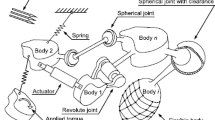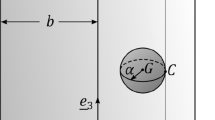Abstract
In this study, we present explicit equations of motion for general mechanical systems exposed to holonomic and nonholonomic constraints based on the Gibbs-Appell formulation. Without constructing the Gibbs function, the proposed method provides a minimal set of first-order dynamic equations applicable for multibody constrained systems. Transforming the Newton–Euler equations from physical coordinates to quasivelocity spaces eliminate constraint reaction forces from motion equations. In this study, we develop a general procedure to select effective quasivelocities, which indicate that the proposed quasivelocities satisfy constraints, eliminate Lagrange multipliers, and reduce the number of dynamic equations to degrees of freedom. Besides, we test the validity and efficiency of the proposed approach using three constrained dynamical systems as illustrative examples. Finally, we compare the simulation results with Udwadia–Kalaba, augmented Lagrangian, and other conventional methods.












Similar content being viewed by others
References
Ginsberg, J.H.: Advanced Engineering Dynamics. Cambridge University Press, Cambridge (1998)
Bajodah, A.H., Chen, Y.-H.: Canonical generalized inversion form of Kane’s equations of motion for constrained mechanical systems. In: Nonlinear Systems: Modeling, Estimation, and Stability, p. 31 (2018)
Vilkko, R., et al.: Landmark writings in Western mathematics 1640–1940. Rev. Mod. Log. 11(1–2), 205–218 (2007). Edited by I. Grattan-Guinness
Náprstek, J., Fischer, C.: Appell–Gibbs approach in dynamics of non-holonomic systems. In: Nonlinear Systems-Modeling, Estimation, and Stability. IntechOpen, London (2018)
Desloge, E.A.: Relationship between Kane’s equations and the Gibbs–Appell equations. J. Guid. Control Dyn. 10(1), 120–122 (1987)
Borri, M., Bottasso, C., Mantegazza, P.: Equivalence of Kane’s and Maggi’s equations. Meccanica 25(4), 272–274 (1990)
Maggi, G.A.: Principii della teoria matematica del movimento dei corpi: corso di meccanica razionale. Ulrico Hoepli, Milano (1896)
Laulusa, A., Bauchau, O.A.: Review of classical approaches for constraint enforcement in multibody systems. J. Comput. Nonlinear Dyn. 3(1), 011004 (2008)
Bajodah, A.H., Hodges, D.H., Chen, Y.-H.: New form of Kane’s equations of motion for constrained systems. J. Guid. Control Dyn. 26(1), 79–88 (2003)
Pishkenari, H.N., Yousefsani, S., Gaskarimahalle, A., Oskouei, S.: A fresh insight into Kane’s equations of motion. Robotica 35(3), 498–510 (2017)
Udwadia, F.E., Kalaba, R.E.: A new perspective on constrained motion. Proc. R. Soc. Lond. Ser. A, Math. Phys. Sci. 439(1906), 407–410 (1992)
Udwadia, F., Kalaba, R.: The explicit Gibbs-Appell equation and generalized inverse forms. Q. Appl. Math. 56(2), 277–288 (1998)
Blajer, W.: A geometrical interpretation and uniform matrix formulation of multibody system dynamics. J. Appl. Math. Mech./Z. Angew. Math. Mech. 81(4), 247–259 (2001)
Pishkenari, H.N., Heidarzadeh, S.: A novel computer-oriented dynamical approach with efficient formulations for multibody systems including ignorable coordinates. Appl. Math. Model. 62, 461–475 (2018)
Marques, F., Souto, A.P., Flores, P.: On the constraints violation in forward dynamics of multibody systems. Multibody Syst. Dyn. 39(4), 385–419 (2017)
Bayo, E., De Jalon, J.G., Serna, M.A.: A modified Lagrangian formulation for the dynamic analysis of constrained mechanical systems. Comput. Methods Appl. Mech. Eng. 71(2), 183–195 (1988)
Bayo, E., Ledesma, R.: Augmented Lagrangian and mass-orthogonal projection methods for constrained multibody dynamics. Nonlinear Dyn. 9(1–2), 113–130 (1996)
Dopico, D., González, F., Luaces, A., Saura, M., García-Vallejo, D.: Direct sensitivity analysis of multibody systems with holonomic and nonholonomic constraints via an index-3 augmented Lagrangian formulation with projections. Nonlinear Dyn. 93(4), 2039–2056 (2018)
Mata, V., Provenzano, S., Valero, F., Cuadrado, J.: Serial-robot dynamics algorithms for moderately large numbers of joints. Mech. Mach. Theory 37(8), 739–755 (2002)
Vossoughi, G., Pendar, H., Heidari, Z., Mohammadi, S.: Assisted passive snake-like robots: conception and dynamic modeling using Gibbs–Appell method. Robotica 26(3), 267–276 (2008)
Korayem, M., Shafei, A., Shafei, H.: Dynamic modeling of nonholonomic wheeled mobile manipulators with elastic joints using recursive Gibbs–Appell formulation. Sci. Iran. 19(4), 1092–1104 (2012)
Korayem, M., Shafei, A.: Application of recursive Gibbs–Appell formulation in deriving the equations of motion of \(n\)-viscoelastic robotic manipulators in 3D space using Timoshenko beam theory. Acta Astronaut. 83, 273–294 (2013)
Korayem, M., Shafei, A., Dehkordi, S.: Systematic modeling of a chain of \(n\)-flexible link manipulators connected by revolute–prismatic joints using recursive Gibbs–Appell formulation. Arch. Appl. Mech. 84(2), 187–206 (2014)
Marghitu, D.B., Cojocaru, D.: Gibbs–Appell equations of motion for a three link robot with MATLAB. In: Advances in Robot Design and Intelligent Control, pp. 317–325. Springer, Berlin (2016)
Malayjerdi, M., Akbarzadeh, A.: Analytical modeling of a 3-d snake robot based on sidewinding locomotion. Int. J. Dyn. Control 7(1), 83–93 (2019)
Baruh, H.: Applied Dynamics. CRC Press, Boca Raton (2014)
Gallier, J., et al.: The Schur Complement and Symmetric Positive Semidefinite (and Definite) Matrices, pp. 1–12. Penn Engineering, University of Pennsylvania (2010)
Mirtaheri, S.M., Zohoor, H.: Quasi-velocities definition in Lagrangian multibody dynamics. Proc. Inst. Mech. Eng., C J. Mech. Eng. Sci. 0954406221995852 (2021)
Udwadia, F.E., Phohomsiri, P.: Explicit equations of motion for constrained mechanical systems with singular mass matrices and applications to multi-body dynamics. Proc. R. Soc. A, Math. Phys. Eng. Sci. 462(2071), 2097–2117 (2006)
Uchida, T., Vyasarayani, C., Smart, M., McPhee, J.: Parameter identification for multibody systems expressed in differential-algebraic form. Multibody Syst. Dyn. 31(4), 393–403 (2014)
Zhang, J., Liu, D., Liu, Y.: A constraint violation suppressing formulation for spatial multibody dynamics with singular mass matrix. Multibody Syst. Dyn. 36(1), 87–110 (2016)
Author information
Authors and Affiliations
Corresponding author
Additional information
Publisher’s Note
Springer Nature remains neutral with regard to jurisdictional claims in published maps and institutional affiliations.
Appendices
Appendix A
Selecting quasivelocities based on the general proposed procedure in this research and using Eq. (35), we have
where \(\left [y\right ]\) is an arbitrary square matrix \(\in {\mathbb{R}}^{p}\times {\mathbb{R}}^{p}\), and
Based on Eq. (12), we have
Differentiation of Eq. (69) with respect to time yields
By partitioning a matrix into four blocks, it can be inverted clockwise as
where A, B, C, and D have arbitrary sizes. (A and D should be squared so that they can be inverted.) Furthermore, A and \(\left (\mathrm{D-C}{ \mathrm{A}}^{-\mathrm{1}}\mathrm{B}\right )\) must be nonsingular, and
Substituting Eq. (70) into Eq. (72), we have
Multiplying the constraint matrix \(\left [\mathrm{a}\right ]\ \)and \(\left [\Omega \right ]\) yields
Finally, Eq. (27) is proved as follows:
Appendix B
In this annex, we prove that \(\ \frac{\partial {\tilde{\boldsymbol{a}}}_{G}}{\partial \ddot{\boldsymbol{q}}} = \frac{\partial {\tilde{\boldsymbol{v}}}_{G}}{\partial \dot{\boldsymbol{q}}}\). This is an important equation to reduce calculations, where \({\tilde{v}}_{G}\left (\dot{\boldsymbol{q}},\boldsymbol{q},t\right ) \ \text{and}\ {\tilde{a}}_{G}\left (\ddot{\boldsymbol{q}}, \dot{\boldsymbol{q}},\boldsymbol{q},t\right )\) denote the velocity and acceleration vectors of the mass center, respectively, and are defined as follows:
To simplify the formulation, the velocity vector can be written in following matrix notation:
where \(\boldsymbol{\eta }(\boldsymbol{q},t)\in { \mathbb{R}}^{\mathrm{6}}\times {\mathbb{R}}^{n}\) and \(\boldsymbol{\kappa }(\boldsymbol{q},t) \in {\mathbb{R}}^{\mathrm{6}}\) are functions of generalized coordinates, vector \(\boldsymbol{q}\), and time. In addition, the generalized acceleration vector can be expressed in terms of kinematic characteristics by taking the time derivative of Eq. (78) leading to the equation
Using definitions (78) and (79), we conclude that the \(\mathit{jacoobian}\left (\left \{ {\tilde{a}}_{G}\right \} ; \left \{ \ddot{q}\right \} \right )\) is equal to \(\operatorname{jacoobian}\left (\left \{ {\tilde{v}}_{G}\right \} ;\left \{ \dot{q}\right \} \right )\). In fact, we have
Substituting Eq. (80) into Eq. (25) gives the alternative form of \(\left \{ U^{\mathrm{*}}\right \} \) as
Rights and permissions
About this article
Cite this article
Mirtaheri, S.M., Zohoor, H. Efficient formulation of the Gibbs–Appell equations for constrained multibody systems. Multibody Syst Dyn 53, 303–325 (2021). https://doi.org/10.1007/s11044-021-09798-6
Received:
Accepted:
Published:
Issue Date:
DOI: https://doi.org/10.1007/s11044-021-09798-6




